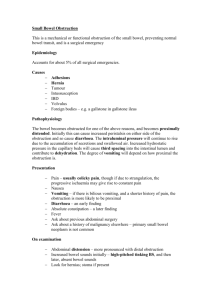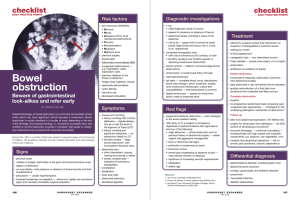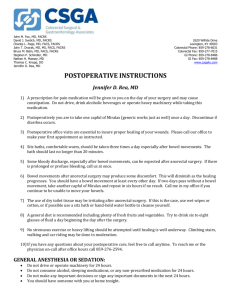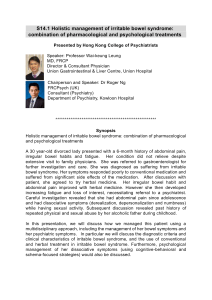Two months ago he underwent an exploratory laparotomy with small
advertisement
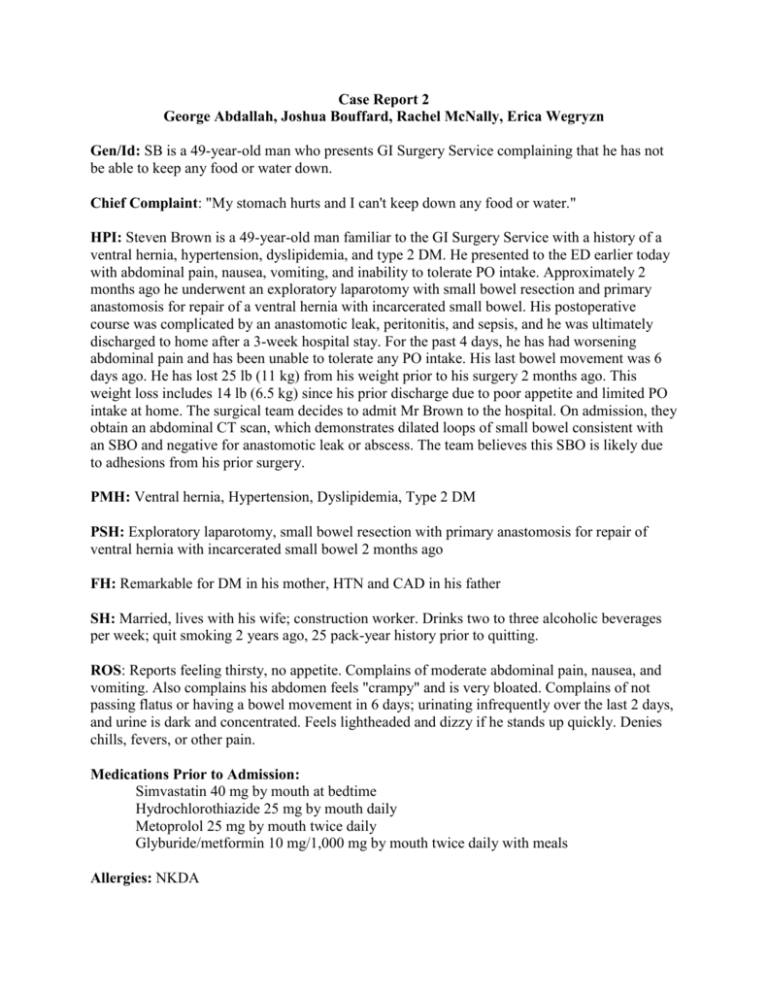
Case Report 2 George Abdallah, Joshua Bouffard, Rachel McNally, Erica Wegryzn Gen/Id: SB is a 49-year-old man who presents GI Surgery Service complaining that he has not be able to keep any food or water down. Chief Complaint: "My stomach hurts and I can't keep down any food or water." HPI: Steven Brown is a 49-year-old man familiar to the GI Surgery Service with a history of a ventral hernia, hypertension, dyslipidemia, and type 2 DM. He presented to the ED earlier today with abdominal pain, nausea, vomiting, and inability to tolerate PO intake. Approximately 2 months ago he underwent an exploratory laparotomy with small bowel resection and primary anastomosis for repair of a ventral hernia with incarcerated small bowel. His postoperative course was complicated by an anastomotic leak, peritonitis, and sepsis, and he was ultimately discharged to home after a 3-week hospital stay. For the past 4 days, he has had worsening abdominal pain and has been unable to tolerate any PO intake. His last bowel movement was 6 days ago. He has lost 25 lb (11 kg) from his weight prior to his surgery 2 months ago. This weight loss includes 14 lb (6.5 kg) since his prior discharge due to poor appetite and limited PO intake at home. The surgical team decides to admit Mr Brown to the hospital. On admission, they obtain an abdominal CT scan, which demonstrates dilated loops of small bowel consistent with an SBO and negative for anastomotic leak or abscess. The team believes this SBO is likely due to adhesions from his prior surgery. PMH: Ventral hernia, Hypertension, Dyslipidemia, Type 2 DM PSH: Exploratory laparotomy, small bowel resection with primary anastomosis for repair of ventral hernia with incarcerated small bowel 2 months ago FH: Remarkable for DM in his mother, HTN and CAD in his father SH: Married, lives with his wife; construction worker. Drinks two to three alcoholic beverages per week; quit smoking 2 years ago, 25 pack-year history prior to quitting. ROS: Reports feeling thirsty, no appetite. Complains of moderate abdominal pain, nausea, and vomiting. Also complains his abdomen feels "crampy" and is very bloated. Complains of not passing flatus or having a bowel movement in 6 days; urinating infrequently over the last 2 days, and urine is dark and concentrated. Feels lightheaded and dizzy if he stands up quickly. Denies chills, fevers, or other pain. Medications Prior to Admission: Simvastatin 40 mg by mouth at bedtime Hydrochlorothiazide 25 mg by mouth daily Metoprolol 25 mg by mouth twice daily Glyburide/metformin 10 mg/1,000 mg by mouth twice daily with meals Allergies: NKDA Physical Examination GEN African-American man, uncomfortable because of abdominal pain, appears malnourished VS: BP 96/60, P 108, RR 18, T 37.7°C; Wt 71 kg (wt prior to surgery 2 months ago 83 kg), Ht 71 in (180 cm) SKIN Dry, flaking in some spots, poor turgor HEENT PERRLA, EOMI, anicteric sclerae, normal conjunctivae, mouth is dry, pharynx is clear, some evidence of wasting noted on temporal lobes, eyes appear sunken in, orbital ridge protruding somewhat. LUNGS/THORAX CTA and percussion bilaterally; bilateral protruding scapulae CV RRR, no murmurs ABD Distended; hypoactive (nearly absent) bowel sounds; diffuse tenderness throughout all four quadrants GENIT/RECT No lesions, no internal masses MS/EXT (–) Cyanosis, (–) edema, 2+ dorsalis pedis and posterior tibial pulses bilaterally, some evidence of wasting in large muscle groups (biceps, triceps, and quadriceps) NEURO A & O x 3; CN II–XII intact; motor 5/5 upper and lower extremity bilaterally; sensation intact and reflexes symmetric with downgoing toes Labs on Admission Na 132 mEq/L Hgb 12.1 g/dL AST 24 IU/L Ca 8.2 mg/dL K 3.3 mEq/L Hct 35.9% ALT 21 IU/L Mg 1.4 mEq/dL Cl 94 mEq/L Plt 334 x 103/mm3 Alk phos 41 IU/L Phos 2.6 mg/dL CO2 34 mEq/L WBC 7.5 x 103/mm3 GGT 45 IU/L PT 12.3 s BUN 17 mg/dL T. bili 0.9 mg/dL INR 0.8 SCr 0.5 mg/dL T. prot 4.9 g/dL Glu 142 mg/dL Alb 2.9 g/dL Radiology A CT scan with contrast demonstrates dilated loops of small bowel consistent with SBO; negative for anastomotic leak; negative for abscess.Two months ago he underwent an exploratory laparotomy with small bowel resection and primary anastomosis to repair a ventral hernia with incarcerated small bowel. SBO was managed conservatively due to recent abdominal surgery with residual inflammation and adhesions. He was made nothing by mouth and all by mouth medications are held. Gastric decompression was performed via a nasogastric tube and a peripherally inserted central catheter (PICC) was inserted for administration of parenteral and intravenous (IV) fluids. SB was given 1,000mL IV fluid bolus with normal saline followed by normal saline 100mL/h. Problem List: 1. Malnutrition 2. SBO 3. Diabetes 4. Venous Thromboembolism 5. Hypertension 6. Hyperlipidemia Severe Malnutrition: S: SB is a 49 yo male presenting to the GI Surgery Service complaining “my stomach hurts and I can’t keep down any food or water.” He is currently suffering from a ventral hernia and his past medical history is significant for HTN, dyslipidemia, and T2DM. He is currently complaining of abdominal pain, nausea, vomiting, and the inability to tolerate anything by mouth. He recently underwent an exploratory laparotomy 2 months ago with small bowel resection and primary anastomosis for repair of the ventral hernia with incarcerated small bowel. In his post-op he developed an anastomotic leak, peritonitis, and sepsis, causing him to stay in the hospital for 3 weeks. His abdominal pain has worsened the past 4 days and his last bowel movement was 6 days ago. He has lost 11kg prior to his surgery 2 months ago. In addition to this, he has lost an additional 6.5kg since his discharge from the hospital. Upon admission to the hospital, a recent CT scan reveals dilated loops of small bowel consistent with an SBO and negative for anastomotic leak or abscess. Upon questioning, SB reports having no appetite and feeling thirsty. His abdomen feels “crampy” and is very bloated. He is not passing flatus and is urinating frequently over the last 2 days that is dark and concentrated. He feels lightheaded and dizzy if he stands up quickly. He denies chills, fever, or other pain. O: Allergies: NKDA Medications: Simvastatin 40mg by mouth at bedtime Hydrochlorothiazide 25 mg by mouth daily Metoprolol 25mg by mouth twice daily Glyburide/metformin 10mg/1,000 mg by mouth twice daily with meals PMH: Ventral Hernia Hypertension Dyslipidemia Type 2 Diabetes Mellitus Physical Examination Gen: African-American man, uncomfortable due to abdominal pain, appears malnourished VS: BP 96/60, P 108, RR 18, T 37.7°C; Wt 71 kg (weight prior to surgery 2 months ago ~83kg), Ht 71in Skin: Dry, flaking in some spots, poor turgor HEENT: PERRLA, EOMI, anicteric sclerae, normal conjunctivae, mouth is dry, pharynx is clear, some evidence of wasting noted on temporal lobes, eyes appear sunken in, orbital ridge protruding somewhat. Lungs/Thorax: Bilateral protruding scapulae ABD: Distended; hypoactive (nearly absent) bowel sounds; diffuse tenderness throughout all four quadrants GENIT/RECT: no lesions, no internal masses MS/EXT: some evidence of wasting in large muscle groups (biceps, triceps and quadriceps) Labs on Admission Na 132 mEq/L Mg 1.4mEq/dL SCr 0.5 mg/dL GGT 45 IU/L PT 12.3 K 3.3 mEq/L Phos 2.6 mg/dL Glu 142 mg/dL T. Bili 0.9 mg/dL INR 0.8 Cl 94 mEq/L Alk phos 41 IU/L AST 24 IU/L T. prot 4.9 g/dL Corrected Ca 9.1 mg/dL Ca 8.2 mg/dL CO2 34 mEq/L ALT 21 IU/L Alb 2.9 g/dL CrCl: 179.5 mL/min Radiology CT scan with contrast demonstrates dilated loops of small bowel consistent with small bowel obstruction (SBO); negative for anastomotic leak; negative for abscess. Two months ago he underwent an exploratory laparotomy with small bowel resection and primary anastomosis to repair a ventral hernia with incarcerated small bowel. SBO was managed conservatively due to recent abdominal surgery with residual inflammation and adhesions. He was made nothing by mouth and all by mouth medications are held. Gastric decompression was performed via a nasogastric tube and a peripherally inserted central catheter (PICC) was inserted for administration of parenteral and intravenous (IV) fluids. SB was given 1,000mL IV fluid bolus with normal saline followed by normal saline 100mL/h. A: SB is a 49 year old male presenting to the emergency department with moderate abdominal pain, unable to tolerate anything by mouth and with no bowel movement in the past 6 days. CT scan reveals a small bowel obstruction making him a candidate for parenteral nutrition. Therefore, it is necessary to reevaluate SB’s pharmacological regimen to better control his malnutrition in an effort to prevent the progression of his condition, reduce any long-term complications, and optimize his quality of life. According to the Subjective Global Assessment, a diagnostic tool used to assess the degree of malnutrition, SB is currently categorized as severely malnourished1. Severe malnutrition is characterized by inadequate dietary intake for 1 month or longer with a history of anorexia, nausea, or diarrhea for 2 weeks or more. In this particular case, SB has had a poor appetite and limited intake by mouth at home since his surgery two months ago. He also complains of moderate abdominal pain, nausea and vomiting, and not passing flatus or having a bowel movement for the past 6 days. The Subject global assessment also states that a person may have severe malnutrition if they have had a 10% or greater weight loss in less than 6 months1. SB lost 11kg prior to his surgery two months ago and has lost 6.5 kg since the surgery. In addition to this, his serum albumin levels are 2.9 mg/dl and total protein levels are 4.9 g/dL. SB’s hypoalbuminemia and lower serum protein concentrations are also indicative of malnutrition. The American Society for Parenteral and Enteral Nutrition and the Society of Critical Care Medicine define the goals of therapy as treating and controlling the patient’s abdominal pain, nausea and vomiting2. Furthermore, treatment should be designed to correct any malnutrition and prevent further nutritional deficiencies. To do this, treatment should correct fluid, electrolyte, acid-base abnormalities and promote a stable nitrogen balance. Lastly, over-arching goals of therapy include avoiding refeeding syndrome and preventing venous thromboembolism. According to the American Society for Parenteral and Enteral Nutrition, enteral nutrition is the preferred method for nutritional support when oral nutrition is not possible2. Enteral nutrition works to help maintain the responsiveness of the immune system and the integrity of the gut bacteria. In addition to this, enteral feeding helps to maintain the integrity of the mucosal bowel, which prevents the translocation of pathogens and bacteria into systemic circulation. However, enteral nutrition is contraindicated in patients with necrotizing enterocolitis and obstruction of the bowel. In this particular case SB, has been unable to tolerate anything by mouth and has experienced no bowel movements in the past 6 days. Additionally, SB has a history of small bowel resection, which would make enteral nutrition inappropriate in this case. With obstruction, nutrients are unable to pass through the GI tract, which limits the degree in which they are absorbed. Consequently, the patient will continue to experience abdominal distention, pain, and vomiting; therefore, parenteral route of administration would be the preferred method of nutrition delivery in SB. The two routes to provide parenteral nutrition are through a peripheral vein or through a central vein2. Central parenteral nutrition is the preferred method of administration, because the catheter accommodates larger volumes of solutions. When administered, these large volumes are better tolerated by the patient and are less likely to cause venous irritation and thrombosis. In a randomized study of 102 hospitalized adults requiring total parenteral nutrition vs. centrallyinserted subclavian catheter, there were higher rates of thrombophlebitis with peripheral vein TPN3. Therefore, since SB has severe malnutrition and is need of micronutrients, the central line method would be preferred. Parenteral admixtures can also be formulated to also administer nutrients to the patient through the central line. Various options for parenteral admixtures include 2-in-1 formulations, and total nutrient admixtures. A 2-in-1 admixture is prepared with a mixture of dextrose and amino acids in one bag2. This combination is characterized by an acidic pH which is a poor media for microbial growth. 2-in-1 solutions allow for greater flexibility in dextrose and amino acids provided, but require additional tubing to deliver lipids. On the other hand, the total nutrient admixture contains a mixture of a fatty emulsion with a dextrose and amino acid solution. This admixture, however, has an increased risk for microbial growth, and would put SB at an increased risk of infection. In addition to deciding on which form of parenteral nutrition to use, the components of the TPN need to also be considered. To guide treatment, the patient’s estimated fluid requirements need to be calculated while also accounting for SB’s risk of refeeding syndrome. To avoid any abrupt shifts in fluids and electrolytes, the guidelines recommend that approximately 50% of the fluid requirements be administered over 3 to 5 days2. Furthermore, under most circumstances, a normal TPN is composed of carbohydrates, protein, lipids, electrolytes and minerals. The caloric composition consists of carbohydrates, which are administered in the form of dextrose, at roughly 50-60% of the admixture, whereas proteins are roughly 20% and lipid substances are about 30%; therefore, the TPN should be formulated to meet these requirements2. Hyperglycemia is also a common clinical manifestation in patients receiving parenteral nutrition. With his past medical history of Type 2 Diabetes Mellitus, SB is at particular risk for this complication. Currently his glucose levels are elevated at 142 mg/dL. Through an updated study conducted in 2012, the American Society for Parenteral and Enteral Nutrition recommends a target glucose goal range of 140-180mg/dL2. Glucose levels should be monitored every six hours and can be done so via the finger stick method. SB also presents with an underlying small bowel obstruction. Small bowel obstruction, or SBO, is a mechanical or functional obstruction of the intestines, which prevents the normal transit of the products of digestion4. SBOs often occur after a complicated abdominal surgery or if a patient has experienced a hernia. Depending on the level of obstruction, bowel obstructions can present with abdominal pain, swelling within the abdomen, constipation, and vomiting. Complications of SBO may include electrolyte deficiencies and dehydration due to vomiting. In small bowel obstruction the pain tends to be colicky (cramping and intermittent) in nature, with spasms lasting a few minutes. In this particular case, SB underwent a laparotomy with small bowel resection two months ago. He also presents with complaints of moderate abdominal pain, nausea, and vomiting and also states that his abdomen feels "crampy" and very bloated. These risk factors can greatly worsen his small bowel obstruction. According to the guidelines for the management of small bowel obstruction, goals of therapy include distinguishing mechanical obstruction from the ileus of the small intestines, determining the etiology of the obstruction, removing the obstruction, and alleviating symptoms4. The standard therapy for SBO is expeditious surgery4. Surgery is indicated if peritonitis is present and signs of clinical deterioration of bowel strangulation are present. In this condition the bowel becomes twisted around fibrous tissue, decreasing the blood supply and becoming necrotic. Signs and symptoms include metabolic acidosis, fever, leukocytosis, tachycardia, and continuous pain4. Expeditious surgery works to minimize the risk for bowel strangulation, which is associated with an increased risk for morbidity and mortality4. Because of SB’s recent abdominal surgery, the team would like to avoid reentering the abdomen for surgical intervention at this time (the patient is likely to still have inflammation and adhesions from his prior operation, and additional surgical intervention can further increase inflammation and risk of complications [e.g., adhesions, fistula]). The surgical team has decided to manage his SBO conservatively (non-operatively). In a randomized study in 128 patients with partial adhesive small bowel obstruction, oral triple therapy was found to lessen the obstruction and reduce the need for surgery5. Oral therapy included laxative (magnesium oxide 500 mg), digestant (Lactobacillus acidophilus 0.3 g), and defoaming agent (simethicone 40 mg) 3 times daily with nasogastric tube clamped for 1 hour after oral medication administration5. This may be considered an option, but there might be a need for more evidence to support this pharmacotherapeutic regimen. Therefore, the best option at this point would be told temporarily hold all “by mouth” medications until the SBO has resolved. SB also presents with an increased risk of venous thromboembolism. Venous thromboembolism is characterized by the formation of a blood clot within the venous blood system. This clot can potentially embolize and enter systemic circulation, which can then lead to a life-threatening pulmonary embolism. Using the Caprini score, which assesses a patient’s risk of developing a thromboembolism, SB currently has a score of six.6 A score of five or greater is associated with a 40-80% risk of venous thromboembolism formation6. Due to his recent surgery, bed rest and central venous line, SB is currently at an increased risk for a venous thromboembolism. Therefore, to reduce his risk of developing a clot, prophylactic therapy should be initiated. The American College of CHEST Physicians guidelines recommend pharmacological prophylaxis with low weight molecular heparin (LWMH) or low does unfractionated heparin in abdominal surgery patients with a Caprini score of greater than or equal to five.7 SB is high a risk patient, therefore the Chest Guidelines report grade 2 evidence for the use of LMWH for major bleeding7. The guidelines also recommend mechanical prophylaxis with pressure stockings. Due to his lack of ambulation, SB also qualifies for pressure stocking prophylaxis. P: Temporarily hold all by mouth medications until the malnutrition and SBO have resolved. Due to recent surgery and likely adhesions, a conservative non-surgical approach is appropriate for SBO. Follow-up serial abdominal examinations for signs of further peritonitis three times a day. Monitor for any signs of bowel strangulation including: o Metabolic acidosis o Fever o Leukocytosis o Tachycardia o Continuous pain If no signs of improvement re-perform second CT scan in 48 hours Administer Prochlorperazine 10 mg IV every 6 hours as needed for nausea and vomiting. Initiate a fluid bolus of Normal Saline, followed by maintenance Normal Saline IV at 100 mL/hr for fluid resuscitation. Monitor the patient for signs of refeeding syndrome within first 5 days of therapy. Initiate Total Parenteral Nutrition (central line) over 24 hours at a rate of 83 ml/hr for about 7-10 days. PN will contain: o Total fluid formulation: 2,000 mL/day To avoid fluid overload and refeeding syndrome: 1000 mL/day over 3-5 days o Total caloric requirement: 2,100 kcal/day o Protein requirement: 440 kcal/day o Dextrose requirement: 1030 kcal/day o Lipid requirement: 630 kcal/day Electrolyte Components: o NaCl 50mEq/L o Na acetate 50 mEq/L o Na phosporous 0 o KCl 75 mEq/L o K Acetate 0 o K phosphorous 20 mMol o Mg 10 mEq/L o Ca 10mEq/L Additive Components: o Multivitamin (MVI) 10 mL o Give Thiamine 100 mg IV daily for 5-7 days o Folic Acid 1 mg daily for 5-7 days o Multi trace element injection Enoxaparin 40 mg subcutaneously once a day. o Pharmacy will educate patient on how to administer subcutaneously. o Patient should monitor for any signs of bleeding such as black tarry stools and red blood in rectum. o Patient should contact his primary care physician or pharmacist if bleeding becomes persistent or severe. Education: Stress the importance of continued smoking cessation. Patient should also limit alcohol consumption to 1-2 drinks/day. Educate patient on signs and symptoms of Pulmonary embolism, particularly chest pain, shortness of breath, and cough. Monitoring o Obtain daily weights, vital signs and fluid balance o Monitor glucose levels via fingerstick every 6 hours o Measure serum electrolytes: sodium, potassium, magnesium, BUN and creatinine at least daily until TPN goals are reached, and then transition to two to three times daily. o Monitor triglyceride levels, LFTs (ALT, AST, alkaline phosphatase), and total bilirubin after establishing a baseline one to two times per week. Follow up with patient in 2 weeks and assess symptoms and possible need for surgical intervention. References 1. Khursheed Jeejeebhoy, Wesley, John. Subjective Global Assessment. A Highly Reliable Nutritional Assessment Tool. 2012 http://subjectiveglobalassessment.com/ 2. A.S.P.E.N. Board of Directors and the Clinical Guidelines Task Force. Guidelines for the Use of Parenteral and Enteral Nutrition in Adult and Pediatric Patients. JPEN J Parenter Enteral Nutr 2002; 26 (1 Suppl): 1SA-138SA 3. Cowl CT, Weinstock JV, Al-Jurf A, Ephgrave K, Murray JA, Dillon K. Complications and cost associated with parenteral nutrition delivered to hospitalized patients through either subclavian or peripherally-inserted central catheters. Department of Internal Medicine, Mayo Clinic and Mayo Medical School. Clin Nutr. 2000 Aug;19(4):237-43. 4. Hayanga, Awori, Wilkens, Kirsten. Current Management of Small Bowel Obstruction. Department of Surgery. Baltimore, Maryland. Advances in Surgery. 2005. 5. Chen SC, Yen ZS, Lee CC, Liu YP, Chen WJ, Lai HS, Lin FY, Chen WJ. Nonsurgical management of partial adhesive small-bowel obstruction with oral therapy: a randomized controlled trial. Department of Emergency Medicine, National Taiwan University Hospital and National Taiwan University College of Medicine, Taipei, Taiwan. CMAJ. 2005 Nov 8;173(10):1165-9. 6. Joseph A. Caprini. Thrombosis Risk Assessment as a Guide to Quality Patient Care. Disease-a-Month, Volume 51, Issues 2–3, February–March 2005, Pages 70–78 7. Guyatt GH, Akl EA, Crowther M, Gutterman DD, Schuünemann HJ, and for the American College of Chest Physicians Antithrombotic Therapy and Prevention of Thrombosis Panel (February 2012). "Executive Summary: Antithrombotic Therapy and Prevention of Thrombosis, 9th ed: American College of Chest Physicians EvidenceBased Clinical Practice Guidelines". Chest 141 (2 suppl): 7S–47S. doi:10.1378/chest.1412S3. PMC 3278060. PMID 22315257

